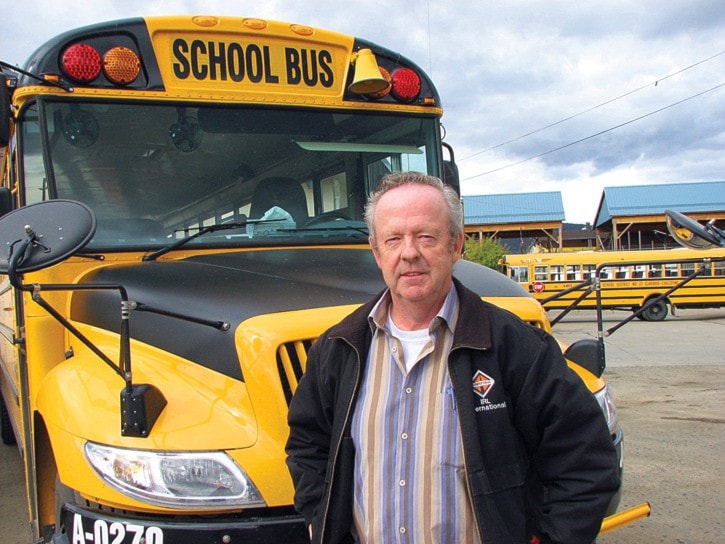Now that the pages have turned to the second month of school, numbers in Cariboo Chilcotin School District No. 27 indicate around 3,100 students are riding the district’s school buses.
“We’re going on last year’s numbers and we should be very close. It’s a busy bus system,” district assistant transportation manager Tony Poole said at his office in Williams Lake last week.
Poole oversees 55 buses — 34 are based out of Williams Lake and 21 out of 100 Mile House. A mechanic by trade, he’s been with the school district for 19 years and in his present position for the last two and a half years.
According to the school district’s secretary treasurer Bonnie Roller, the current total student head count for the entire district is 5,198. That means more than half of the district’s students are being transported to school by bus.
“Some of those 3,100 could be taking two different buses, and there are around 150 students who only ride the bus on Fridays,” Roller said.
Spanning an area of 65,000-square kilometres, the district’s jurisdiction is from 70 Mile House at the south end, taking in the Bridge Lake and Horse Lake area, McLeese Lake to the north, Horsefly and Likely to the east, and as far as Anahim Lake to the west.
“Someone told me once the district is the size of New Brunswick,” Poole said. The fleet puts on a staggering 8,100 km a day.
In fact, one of the earliest bus riders is a student from Likely that boards the bus at 6 a.m. every morning to travel into Williams Lake to attend high school. Other buses are heading out from Williams Lake at 6:15 a.m. each morning.
To keep travel at a minimum, there are buses that stay out permanently in the communities of Anahim Lake, Tatla Lake, Nemiah Valley, Alexis Creek, Likely and Horsefly, driven by people who live in the communities.
When those buses are due for their 5,000 km maintenance, extra buses are sent to replace them.
Aside from rural based buses, the fleet contains a boarding bus that transports high school students from remote Chilcotin communities into Williams Lake on Sunday afternoons, returning them home on Fridays, three buses that can accommodate students with special needs, and two buses with wheelchair accessibility.
In 2010, the provincial government funded the purchase of 11 new clean diesel buses to replace some of the older ones in the district.
Poole said the remaining buses in the fleet are all around 2005 and 2006 vintage.
“The conventional front-end engine models run for about 10 years or 400,000 kilometres and the rear-engine models can go as high as 15 years,” he said.
Retired buses normally go to auction or, as was the case in 2010, are traded in to the dealer.
Roller said annual funding of about $4.3 million comes to the district from the Ministry of Education, through its transportation and housing program.
According to the ministry, current legislation permits, but does not require, school districts to provide student transportation services. In 2010, $87.9 million went to districts across the province to fund those costs.
In 2003, added Roller, the Liberal government decided to look at changing the funding formula, and since then the funding levels have been frozen.
The ministry said a review committee, made up of superintendents and staff from both rural and urban schools across the province, meets annually in late fall or early winter to look at the funding formula, but confirmed no new funding formula has been recommended to date.
Anticipating changes to the formula, School District 27 began looking at ways to downsize and reorganize the fleet as early as seven years ago, Roller said.
As a result, spending on transportation in the district has gone down, which means more money has been able to go the education side of things.
The district is currently looking at its own transportation review. It began doing research over the summer, and is in the process of preparing what Roller described as a “very large” report.
“Some districts in the province may have larger areas to cover, but the distances between schools in the Cariboo Chilcotin are larger. Part of our review will include a spreadsheet showing all the districts in the province to make some comparisons,” Roller said. “Our bus system has its unique challenges.”
